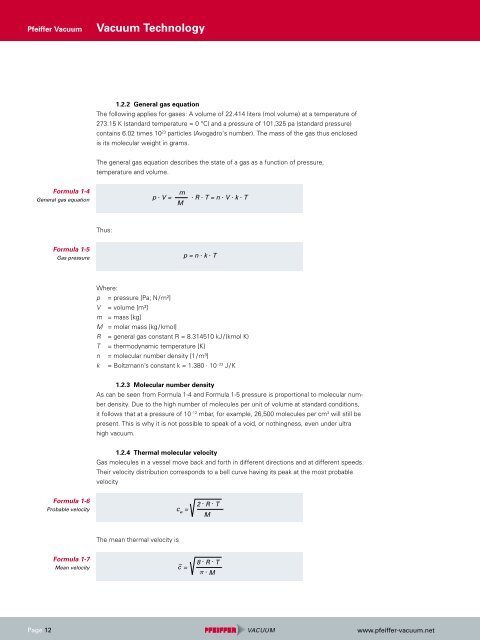You also want an ePaper? Increase the reach of your titles
YUMPU automatically turns print PDFs into web optimized ePapers that Google loves.
Pfeiffer <strong>Vacuum</strong><br />
Formula 1-4<br />
General gas equation<br />
Page 12<br />
Formula 1-5<br />
Gas pressure<br />
Formula 1-6<br />
Probable velocity<br />
Formula 1-7<br />
Mean velocity<br />
<strong>Vacuum</strong> <strong>Technology</strong><br />
1.2.2 General gas equation<br />
The following applies for gases: A volume of 22.414 liters (mol volume) at a temperature of<br />
273.15 K (standard temperature = 0 °C) and a pressure of 101,325 pa (standard pressure)<br />
contains 6.02 times 1023 particles (Avogadro‘s number). The mass of the gas thus enclosed<br />
is its molecular weight in grams.<br />
The general gas equation describes the state of a gas as a function of pressure,<br />
temperature and volume.<br />
Thus:<br />
Where:<br />
p = pressure [Pa; N / m²]<br />
V = volume [m³]<br />
m = mass [kg]<br />
M = molar mass [kg / kmol]<br />
R = general gas constant R = 8.314510 kJ / (kmol K)<br />
T = thermodynamic temperature [K]<br />
n = molecular number density [1 / m³]<br />
k = Boltzmann’s constant k = 1.380 . 10 - 23 J / K<br />
1.2.3 Molecular number density<br />
As can be seen from Formula 1-4 and Formula 1-5 pressure is proportional to molecular number<br />
density. Due to the high number of molecules per unit of volume at standard conditions,<br />
it follows that at a pressure of 10 -12 mbar, for example, 26,500 molecules per cm3 will still be<br />
present. This is why it is not possible to speak of a void, or nothingness, even under ultra<br />
high vacuum.<br />
1.2.4 Thermal molecular velocity<br />
Gas molecules in a vessel move back and forth in different directions and at different speeds.<br />
Their velocity distribution corresponds to a bell curve having its peak at the most probable<br />
velocity<br />
The mean thermal velocity is<br />
m<br />
p . V = . R . T = n . V . k . T<br />
M<br />
c w =<br />
c – =<br />
p = n . k . T<br />
2 . R . T<br />
M<br />
8 . R . T<br />
p . M<br />
www.pfeiffer-vacuum.net

















